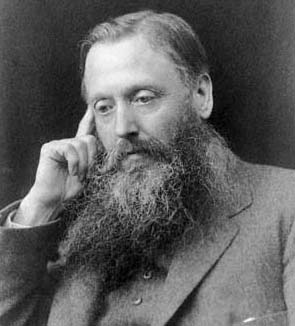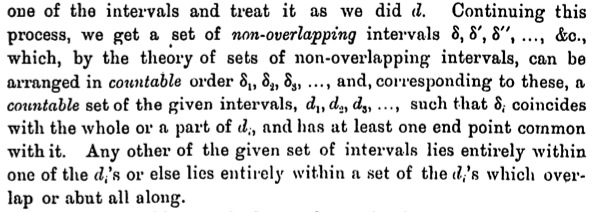- About MAA
- Membership
- MAA Publications
- Periodicals
- Blogs
- MAA Book Series
- MAA Press (an imprint of the AMS)
- MAA Notes
- MAA Reviews
- Mathematical Communication
- Information for Libraries
- Author Resources
- Advertise with MAA
- Meetings
- Competitions
- Programs
- Communities
- MAA Sections
- SIGMAA
- MAA Connect
- Students
- MAA Awards
- Awards Booklets
- Writing Awards
- Teaching Awards
- Service Awards
- Research Awards
- Lecture Awards
- Putnam Competition Individual and Team Winners
- D. E. Shaw Group AMC 8 Awards & Certificates
- Maryam Mirzakhani AMC 10 A Awards & Certificates
- Two Sigma AMC 10 B Awards & Certificates
- Jane Street AMC 12 A Awards & Certificates
- Akamai AMC 12 B Awards & Certificates
- High School Teachers
- News
You are here
An Analysis of the First Proofs of the Heine-Borel Theorem - Young's Proof
Young's Proof
In 1902, W. H. Young published the paper “Overlapping Intervals” in the Bulletin of the London Mathematical Society [19]. This paper is in English and can be found here (pdf download), so we do not provide a translation. The main point of this paper is the following:

Young did not say exactly what “the most important properties” are, but we can take it to mean the union of the countable intervals is equivalent to the union of the original set of intervals. Notice that nothing is mentioned about the overlapping intervals covering a closed and bounded interval.
Clearly once this theorem has been proved, the uncountable version of the Heine-Borel Theorem follows readily. If one has an uncountable cover of a closed and bounded interval, one can determine a countable cover using Young’s theorem and then apply Borel’s countable version of the Heine-Borel Theorem to complete the proof.

William Henry Young (1863-1942) (Convergence Portrait Gallery)
The proof of Young’s result proceeds very much like Borel’s original proof and assumes the same form of completeness. He started by choosing an arbitrary interval \(d.\) He then chose an interval that “abuts or overlaps with \(d\) on the left” and called it \(d^{\prime}.\) He continued in this fashion moving to the left, constructing \(d^{\prime\prime}, d^{\prime\prime\prime},\) etc. He observed (like Borel and Schoenflies) that the left endpoints of these intervals must have “a limiting point \(P\) external to all of them.” He called this limit point \(D.\) “There will only be a finite number of the intervals \(d, d^{\prime}, d^{\prime\prime},\) which do not overlap with \(D.\) Let \(d^{\left(i\right)}\) be the first which overlaps with \(D,\) then we select the intervals \(d, d^{\prime}, d^{\prime\prime}, \dots, d^{\left(i\right)}, D\) and omit from consideration all the intervals \(d^{i+1}, d^{i+2}, \dots.\)”
He continued this operation with the left endpoint of \(D,\) as well as with the right endpoint of the original starting interval \(d.\) Obviously, in order to prove his main theorem, he wanted to show the resulting cover was countable. In order to do this, he passed from his set of overlapping intervals to a new set of non-overlapping intervals in the following way. Starting with \(d\) and \(d^{\prime}\) he defined \(\delta^{\prime}\) to be \(d^{\prime}\setminus d.\) Similarly, he defined \(\delta^{\prime\prime}\) to be \(d^{\prime\prime}\setminus d^{\prime}.\) Each of these \(\delta\) are non-overlapping, and by “the theory of sets of non-overlapping intervals, can be arranged in countable order.”
Then, because the non-overlapping intervals \(\dots,{{\delta}^{\prime\prime\prime}},{{\delta}^{\prime\prime}},{{\delta}^{\prime}},\dots\) are in one-to-one correspondence with the intervals \(\dots,{d^{\prime\prime\prime}},{d^{\prime\prime}},{d^{\prime}},\dots,\) he had created a countable (almost) covering. When two successively chosen intervals in the construction abut (don’t overlap), then the point between them will be not be covered by the union of the intervals. Therefore, there are at most a countable number of points \(p_1,p_2,\dots\) not covered by the intervals determined above. However, each of these \(p_i\) are covered by some interval, so if we append those intervals to the above collection we end up with a countable collection that covers the original union.

Young did not give any detail about the “theory of sets of non-overlapping intervals” but we assume the theorem is exactly the one that Schoenflies referred to in his Bericht.
As above, here are the relevant details of Young’s proof:
Background:
- A discussion of completeness in the form of the monotone convergence property or the Bolzano-Weierstrass property is necessary to understand the proof.
- Some presentation of the “theory of non-overlapping intervals” needs to be done. This step could probably be an exercise to the students, as long as they know some very basic cardinality.
Benefits:
- Young does not require the covering to be countable.
- The proof starts like Borel’s and Schoenflies’ proofs, but the key step requires much less background.
- As with the other similar proofs, Young’s technique is constructive.
- It is in English and is easy to follow.
Drawback:
- This proof is not self-contained. Although the proof does reduce an arbitrary cover to a countable cover, one must then apply Borel’s proof to this countable cover. For a complete argument, both Young and Borel must be taught.
This proof features many of the benefits of the Borel and Schoenflies proofs, but without the drawback of needing advanced set theory. If Borel’s proof has already been covered, this is a quick argument showing the cover need not be countable.
Nicole R. Andre (Wittenberg University), Susannah M. Engdahl (Wittenberg University), and Adam E. Parker (Wittenberg University), "An Analysis of the First Proofs of the Heine-Borel Theorem - Young's Proof," Convergence (August 2013), DOI:10.4169/loci003890




